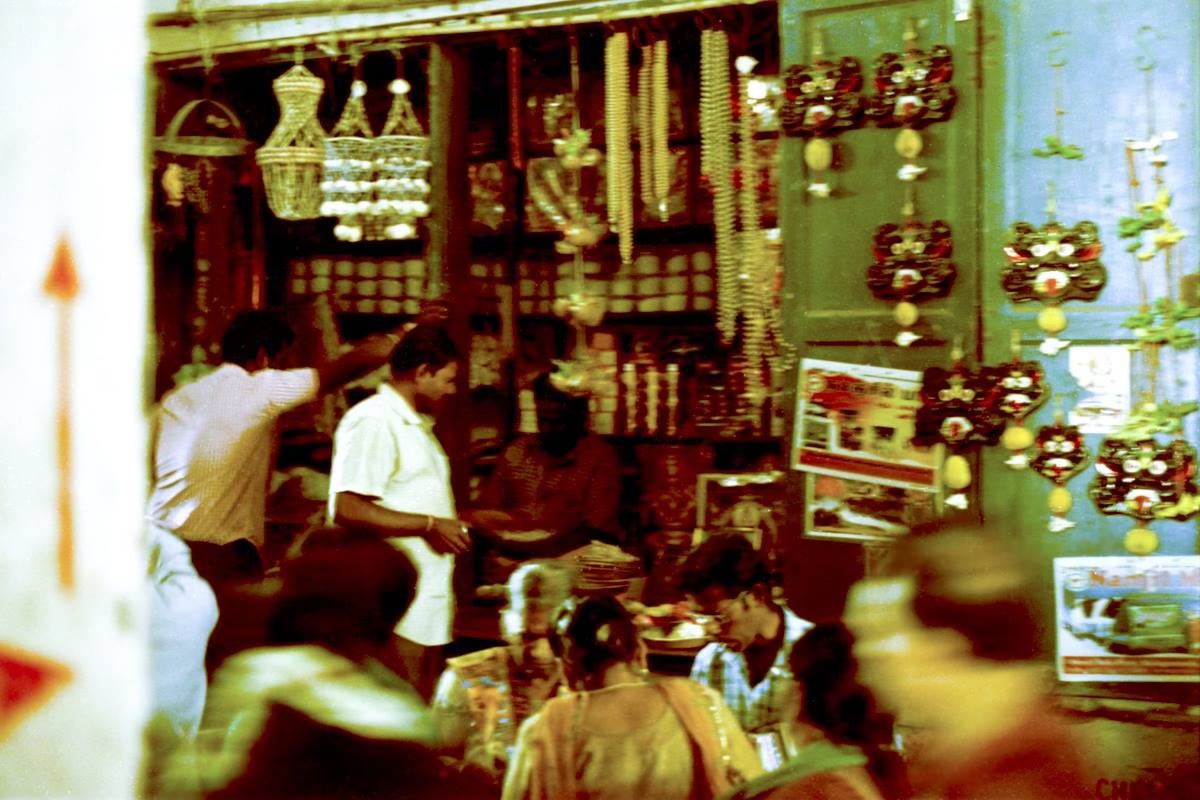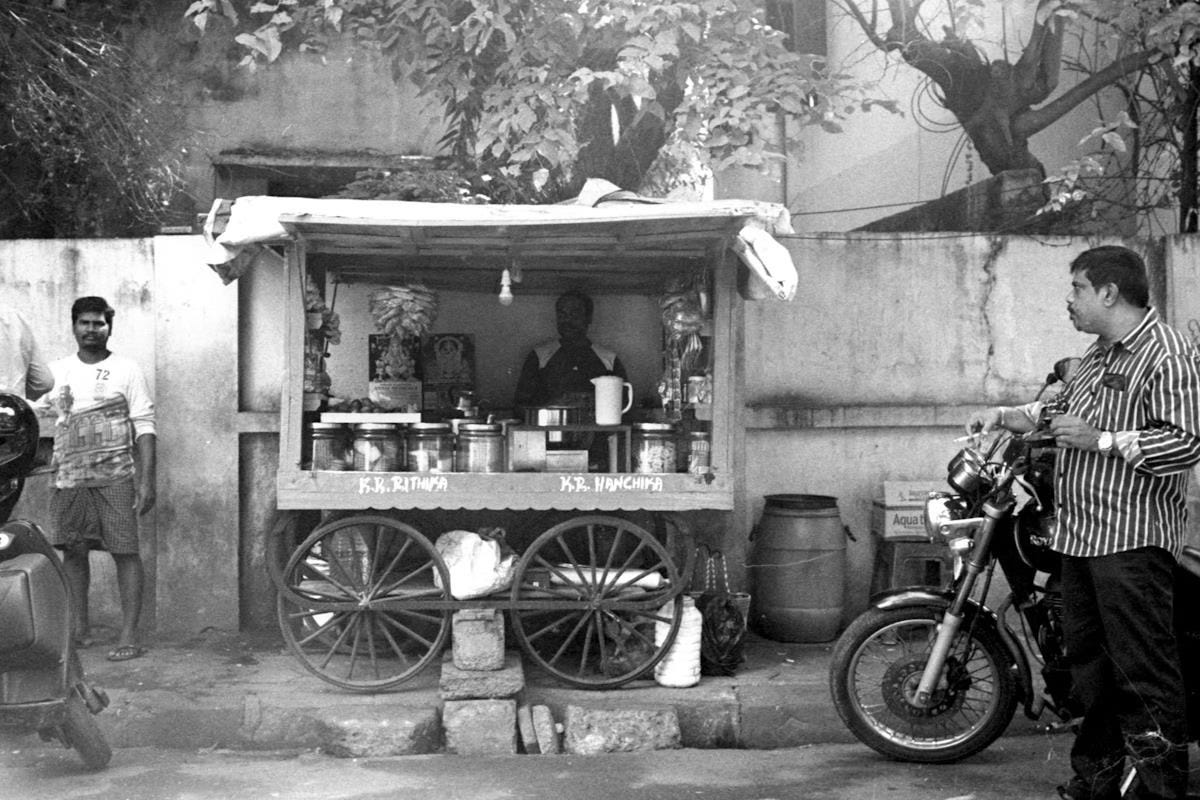Kicking off FED's Global Jam Session with a Feast for All Your Senses
Trumpet-player Indofunk Satish serves up South Indian inspired music, images, and curry
This installment of FED—the first in a new series—is curated by musician, producer, and founder-director of MOMENT NYC, Genji Siraisi. (Genji also contributed original tracks and more to FED’s inaugural season, which you can check out here: 3 Organic Music Cuts Served with a Free-range Emotion Medley & a Word Salad, Infused with Young Feels and Matured Memories and Genji's Shepherd's Pie, a Family Recipe.)
MOMENT NYC is a living museum and cultural organization dedicated to the history of music in New York City and supporting its vibrant music communities. Our programs support independent artist communities and individual artistic vision with work opportunities that promote diverse musical connections, and cross-generational dialog drawn from local music history.
In many ways, MOMENT NYC is a global jam session. So it’s fitting that we attempt to create a little communal playlist for the FED dinner party. To pull it off for you, I’m inviting amazing musicians I’ve met and worked with through the years to share original music and personal recipes, along with a little insight into their worlds. We’re kicking things off with Indofunk Satish.
I’ve known Satish for over a decade now. It’s been long enough that I don’t actually remember how we were first introduced, but it’s safe to say, as with many of my musician friends, that it was on a gig with some of our many mutual friends.
Satish has since performed in MOMENT programs and with my band Groove Collective multiple times, and it has always been a pleasure. Not only is he one of the nicest people one could ever hope to meet, he is also an amazing musician and photographer.
A member of the fantastic Brooklyn Raga Massive, Satish’s instrument of choice is the Firebird trumpet. For those who don’t know, the Firebird trumpet is like a regular trumpet with the addition of a small slide, like a trombone!
Brooklyn Raga Massive combines traditional Indian music and instruments with modern-day influences and improvisation. They’re really something special and worth seeing, should you have the opportunity.
—Genji Siraisi
Indofunk Satish

When I was asked to contribute to FED, I realized much to my delight that it combined everything that I am passionate about in life: music, visual art, and food. I am a musician by trade, a film photographer by hobby, and a passionate home cook. In all of these ventures, I emphasize my cultural background as a South Indian.
The photos I’m sharing are from a recent trip to my home state of Tamil Nadu, and the musical selection is a rubato elaboration (aalapana) of a popular South Indian raga called Kiravani.
The following recipe is one of my favorites, also from Tamil Nadu.
Parappu Usili
If you're trying to follow this recipe and don't already have a larder stocked with Indian essentials, then you may have some purchasing to do. All of these ingredients are basic ones that are available at any Indian grocery store.
Ingredients
thoram (toor dal)
kaladai (chana dal)
dried red chilies
vegetable of choice—eg. green beans, leafy greens, or cabbage
oil
asafoetida (hing)
turmeric powder
salt
black mustard seeds
ulundu parappu (urad dal)—optional
curry leaves
Instructions
We'll start with the parappu, which is the Tamil word for pulses. You may be more familiar with the Hindi word, dal. This recipe uses 2 common types of parappu, thoram and kadalai (toor dal and chana dal in Hindi).
Soak the parappu in water with a few dried red chilies (also available at your friendly neighborhood Indian store). You can vary the ratio of thoram to kadalai, but start with a 2:3 ratio. Increasing the thoram will make it softer, and increasing the kadalai will make it crispier.
While this is soaking, let's prepare the vegetable. You can use a wide variety of vegetables, but my favorites are green beans, leafy greens (like chard), and cabbage. You want to pre-cook the veggie just a bit: leafy greens can be boiled whole for a minute and then drained, rinsed in cold water, and chopped. Cabbage and green beans I prefer to cut and pre-fry in oil rather than boil. Get the veggies to just al dente and then put them aside.
Return to your soaked parappu, drain it (reserving the water), and grind it until it's fairly chunky. Definitely don't want it to be smooth. Add a pinch or two of asafoetida (again, available at your Indian store under its Hindi name hing), a bit of turmeric powder, some salt, and just enough of the soaking water to let the blender do its thing (we want this to be relatively dry).
Once ground, grease a plate and dump the ground parappu onto it. The mound should be about an inch tall. Now we're going to steam this for 15 minutes. Take it out and let it cool.
We're going to call this mound usili and chop it up into small pieces once it’s cool. I usually just take a spatula and attack the lump like it insulted my mother. Eventually we want the usili to be fairly small and powdery, but don't do it all in this step; keep the usili chunks to about 1/2" round.
To assemble the full dish.
Heat up some oil in a large frying pan over high heat and add a teaspoon of black mustard seeds (available, guess where?).
Once they start to pop—I'd recommend dropping a lid on the frying pan, unless you enjoy getting hit in the eye with 500-degree micro-bullets—turn off the heat and let the popping fizzle out.
An optional step now is to add some ulundu parappu (urad dal) and fry it on low heat until it starts to turn golden.
Add some curry leaves and the chunky usili and fry it on medium low heat until it turns golden brown, smooshing it down to your preferred size. Some people like it completely gravely, I prefer a few largeish chunks to remain.
Add your vegetable and keep frying until it's all combined.
This is a pretty dry curry, so I like eating it with rasam—a traditional South Indian soup made with tamarind, tomatoes, warming spices, and aromatic herbs, but that's a recipe for another cooking time.
FED is a participant-supported publication and community. We rely on you and the power of your generosity to create community and sustain this project for all.
How it works…
All are welcome at the table, and “Free” subscriptions are offered to every subscriber as a gift from readers who have upgraded to a paid subscription and from the contributors, editors and producers of FED.
Every subscriber—you, too!—is invited and encouraged to pay the gift forward by upgrading to a paid subscription. Your participation is essential to the whole.
Together, we create one great circle of giving and receiving that binds us together in nourishing community.
So, please, upgrade your subscription to paid today, and share the FED bounty!
For more goodies…
Be sure to check out all the wonderful contributions added to the FED table since our launch on the vernal equinox of 2024. Our global collection of musicians, artists, writers, growers, gleaners, cooks, and craftspeople cook up a smorgasbord of aesthetic and literal nourishment for your body and soul. Yum!











I just made this today with beets, something my Mom used to do, where you grate the beets and then pre-fry them before combining with the usili. I also added a small amount of tamarind paste which I think really elevated the flavor!